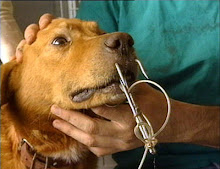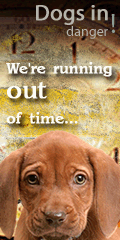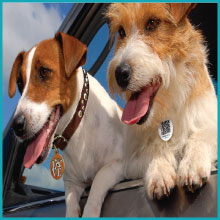Pet Obesity Continues to Grow in U.S.
Nationwide study finds number of overweight dogs and cats increasing; owners of larger dogs and cats less aware of problem.
In the U.S., over 45% of dogs and 58% of cats are now estimated to be overweight or obese according to the Association for Pet Obesity Prevention (APOP). The third annual National Pet Obesity Awareness Day Study, conducted in October 2009, found that from 2007 to 2009, the number of overweight dogs and cats increased by 2% and 5%, respectively.
“Obesity is now the biggest health threat to pets in the US,” states lead researcher Dr. Ernie Ward. “The costs of obesity in illness and injury make it the number one medical issue seen in today’s veterinary hospitals.”
Obesity rates in cats were highest at 21.4%; dogs were slightly better with 8.6% classified as obese by veterinary clinics. Obesity in dogs and cats is typically defined as 30% above normal weight. According to the study, 6.7 million dogs are estimated to be obese and 34.9 million overweight. The numbers in cats is higher, with 20 million estimated to be obese and 54.3 million overweight.
“These numbers, 34 million dogs and 54 million cats that are overweight, continue to slowly creep upwards. The frightening fact is that now pet owners are increasingly classifying their overweight pets as ‘normal,’ making the problem more difficult to address,” notes Dr. Ward. “If this ‘fat gap’ continues to grow, that is, when a pet owner looks at their chubby companion and views it as a normal, healthy weight, our nation’s pets will continue to suffer the consequences of obesity. I believe owners have this misperception because they are surrounded by fatter and fatter pets. Twenty years ago, these dogs were viewed as overweight. Today, pet owners view them as normal.”
When asked, 33% of dog owners and 46% of cat owners with overweight pets incorrectly identified their pet as a normal weight; 25% of dog owners with obese dogs reported their dog was normal while 40% of obese cat owners thought their cat was a normal weight. Interestingly, 33% of small dog (less than 23 pounds) owners thought their overweight dog was a normal weight compared to 41% of large dog (over 50 pounds) owners.
Owners of Labrador Retrievers and Golden Retrievers were more likely to claim their dog was a normal weight when it was in reality, overweight. And 43% incorrectly identified their overweight Retriever as normal while only 33% of small breed dog owners underestimated their dog’s weight. In total, 46% of all Labrador and Golden Retrievers were determined to be overweight or obese. The study found that in general, owners of small breed dogs were more likely to correctly identify their dog as overweight than owners of large breed dogs.
“It’s important that pet owners understand the significance of even a few extra pounds on a dog or cat,” explains Dr. Ward. “For example, a typical 90-pound female Labrador Retriever is equivalent to a 186-pound 5 foot, 4 inch female while a 12-pound Yorkshire Terrier is similar to 223 pounds on the same woman. A 15-pound cat is equivalent to a 225-pound 5 foot, 9 inch male and a 20-pound feline equals 300 pounds on that man. Each pound on a cat is equal to about 13 pounds on the average female and 15 pounds on a male.”
“One encouraging finding was that 82% of pet owners agreed that pet obesity was a problem in the US. The challenge for veterinarians is to educate owners of dogs and cats on what a healthy weight actually is for their pet and offer weight loss strategies,” says Dr. Ward.
Treats continue to be the main culprit for excess weight. According to Ward, 90% of dog owners and 54% of cat owners responded that they gave their pets treats. “Even tiny treats pack a punch,” notes Ward. “Making matters worse, today’s treats are so loaded with sugar and fat I call them ‘kibble crack.’ Modern treats are literally rewiring our pets’ behavioral responses and creating cravings that go far beyond what is normal in many pets.”
Ward stresses that pet owners need to understand the impact treats have on their pets’ weight. For example, he equates a premium pig ear given to a 40-pound dog to drinking six, 12-ounce colas. “No one would sit down and drink six sodas at one time, yet that’s exactly what we’re doing when we give our pets these snacks,” states Dr. Ward. “Even a single, small dog bone treat given to a 10-pound dog is no different than a person eating two chocolate doughnuts. The truth is, we rarely stop at one dog treat. Give a few each day and you’ve fed the equivalent of a dozen doughnuts. No wonder we’re seeing such high obesity rates.”
The third annual National Pet Obesity Awareness Day Study was conducted using data collected by 41 US veterinary clinics in October 2009. In all, about 600 adult dogs and cats were evaluated. Approximately 8.6% of dogs were classified as obese and 36.7% as overweight. Approximately 21.4% of all cats were rated as obese and 36.5% as overweight.
For additional information on the study, please contact Dr. Ernie Ward or visit www.PetObesityPrevention.com.
About the Association for Pet Obesity Prevention (APOP)
APOP was founded in 2005 by Dr. Ernie Ward to promote awareness of the dangers of pet obesity to veterinary healthcare providers and pet owners. APOP is not affiliated with any pet or veterinary company or corporation.
Contact
Dr. Ernie Ward, President Association for Pet Obesity Prevention 910-579-5550 / 910-620-1295 http://www.PetObesityPrevention.com
Wednesday, March 10, 2010
Subscribe to:
Post Comments (Atom)

















No comments:
Post a Comment